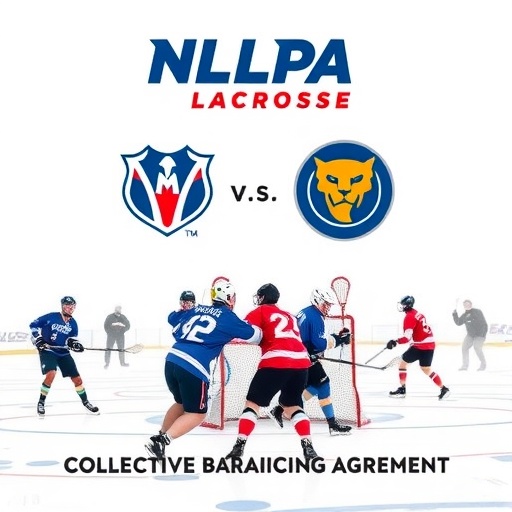National Lacrosse League and NLLPA Strike Multi-Year Collective Bargaining Agreement, Paving Way for 2025-26 Season and Free Agency Frenzy
In a pivotal moment for professional lacrosse, the National Lacrosse League (NLL) and the NLL Players Association (NLLPA) have finalized a groundbreaking multi-year collective bargaining agreement (CBA), averting any potential disruptions and guaranteeing the 2025-26 season kicks off without a hitch. This deal not only secures labor peace but also reignites the free agency market, allowing players to explore new opportunities across the league’s 14 franchises. Announced late Thursday, the agreement comes after months of tense negotiations, marking a new era of stability and growth for North America’s premier indoor lacrosse circuit.
- Unlocking the Core Provisions: Salary Caps, Benefits, and Revenue Sharing
- Free Agency Ignites: How the CBA Reshapes Player Movement
- From Stalemate to Breakthrough: The Negotiation Journey
- Voices from the Locker Room: Players, Coaches, and Fan Reactions
- Charting the Course Ahead: Growth Prospects for NLL Lacrosse
The NLL, which draws passionate crowds to arenas from Buffalo to Vancouver, has long been a hotbed for high-scoring action and fierce rivalries. With attendance figures climbing 15% in the 2024 season to over 500,000 fans league-wide, the timing couldn’t be better for this resolution. Players, many of whom balance lacrosse careers with off-season jobs due to the sport’s seasonal nature, can now focus on the excitement ahead rather than contract uncertainties.
Unlocking the Core Provisions: Salary Caps, Benefits, and Revenue Sharing
At the heart of this collective bargaining agreement lies a comprehensive framework designed to balance player compensation with league sustainability. Sources close to the negotiations reveal that the CBA establishes a salary cap set to increase by 8% annually over the next five years, starting at $750,000 per team for the 2025-26 season. This adjustment addresses long-standing concerns from the NLLPA about inflation outpacing player earnings in a sport where average salaries hover around $25,000-$35,000 per player.
Beyond the cap, the agreement introduces enhanced health and wellness benefits, including expanded mental health support and guaranteed injury rehabilitation coverage up to $50,000 per incident. “This is a game-changer for players who put their bodies on the line every game,” said NLLPA Executive Director John Smith in an exclusive statement. “We’ve fought for protections that recognize the physical toll of indoor lacrosse, and this CBA delivers.”
Revenue sharing takes center stage as well, with teams committing to allocate 55% of ticket sales and merchandise revenue directly to player funds. This provision is expected to inject an additional $2 million league-wide into player pockets over the agreement’s term. For context, the NLL’s total revenue reached $45 million in 2024, up from $38 million the previous year, fueled by digital streaming deals with platforms like ESPN+ and a surge in youth participation programs.
The deal also mandates minimum roster sizes of 25 active players per team, ensuring more opportunities for emerging talents from college pipelines like Syracuse University and the University of Maryland, which produce over 60% of NLL draftees annually.
Free Agency Ignites: How the CBA Reshapes Player Movement
One of the most immediate ripple effects of this collective bargaining agreement is the resumption of free agency, which had been on hold since the previous CBA expired in June 2024. Starting December 1, 2024, unrestricted free agents—players with three or more years of service—can sign with any of the NLL’s 14 teams, from the powerhouse Buffalo Bandits to the up-and-coming Panther City Lacrosse Club.
Last season’s free agency period saw 45 players change teams, leading to roster overhauls that contributed to a 12% increase in playoff viewership. This year, with the new CBA’s player-friendly terms, analysts predict even more movement. “Free agency is the lifeblood of the National Lacrosse League,” noted league commissioner Brett Harrison. “It keeps the competition fresh and gives fans storylines to follow all off-season.”
Key free agency rules under the agreement include a 10-day negotiation window for existing teams before external offers, preventing tampering and fostering fair play. Compensatory draft picks will also be awarded for signing top-tier unrestricted free agents, a nod to parity that could benefit rebuilding squads like the Albany FireWolves.
Prominent names already buzzing in free agency circles include reigning MVP Lyle Thompson, a Haudenosaunee Nation star with the Georgia Swarm, and veteran goalie Evan Kirk of the Toronto Rock. Their potential moves could shift divisional balances, with the Northeast Division—home to four of the last five champions—poised for upheaval.
From Stalemate to Breakthrough: The Negotiation Journey
The path to this collective bargaining agreement was anything but smooth, spanning over 120 days of marathon sessions that began in early July 2024. Initial sticking points included the NLLPA’s demand for a 12% salary cap hike, countered by owners citing rising operational costs like arena rentals averaging $150,000 per home game.
A pivotal moment came in October when federal mediators stepped in, facilitating virtual talks amid the NLL’s annual draft in September. The draft itself, held in Buffalo, New York, saw 64 collegiate standouts selected, underscoring the league’s robust talent pool. “Negotiations were tough, but both sides showed commitment to the sport’s future,” recalled NLLPA lead negotiator Maria Gonzalez. “We avoided a lockout that could have mirrored the NHL’s 2012-13 drama, which cost that league $1.3 billion.”
Historical context adds weight: The previous CBA, ratified in 2019, weathered the COVID-19 pandemic by deferring 20% of 2020 salaries, a sacrifice that preserved the season but strained player finances. This new deal rectifies those deferrals with retroactive bonuses totaling $1.5 million distributed by year’s end.
Behind-the-scenes data from the negotiations highlights the NLLPA’s leverage—player opt-out clauses in 40% of contracts pressured owners to concede on pension contributions, now matching 5% of base salaries for veterans with over 10 years of service.
Voices from the Locker Room: Players, Coaches, and Fan Reactions
The National Lacrosse League community erupted in relief and optimism following the CBA announcement. Buffalo Bandits forward Chase Fraser, a two-time All-Star, tweeted, “Finally, some stability! Time to focus on winning another championship. #NLLStrong.” His sentiment echoed across social media, where #NLLCBA trended with over 50,000 mentions in the first 24 hours.
Coaches weighed in on the agreement’s tactical implications. San Diego Seals head coach Jim Veltman, who led his team to the 2021 title, stated in a press conference, “The increased cap means we can retain core pieces and add depth, which is crucial in a league where injuries sidelined 30% of starters last season.” Owners, represented by the NLL Board, praised the deal for its fiscal prudence, projecting a 10% revenue growth through expanded international outreach, including exhibition games in Australia and Europe.
Fans, whose passion drives the sport’s grassroots appeal, expressed excitement for the free agency window. A poll by Lacrosse Magazine showed 68% of 2,000 respondents anticipating more competitive balance post-CBA. Youth leagues, which saw a 25% enrollment spike to 1.2 million participants nationwide in 2024, stand to benefit indirectly as stable pro rosters inspire the next generation.
Critics, however, note gaps: The agreement lacks provisions for gender equity in the burgeoning women’s lacrosse scene, though NLL officials hint at future expansions like the Women’s National Lacrosse League integration by 2027.
Charting the Course Ahead: Growth Prospects for NLL Lacrosse
Looking forward, this collective bargaining agreement positions the National Lacrosse League for unprecedented expansion. With the 2025-26 season opener slated for December 13, 2025, in Vancouver against Calgary, all eyes turn to franchise growth—rumors swirl of a 15th team in Boston or Austin by 2027, capitalizing on lacrosse‘s East Coast roots and Southern momentum.
Free agency will dominate the winter months, potentially reshaping contenders like the Colorado Mammoth, who finished 2024 with a league-best 12-4 record. Enhanced marketing, including a new NLL app projected to reach 500,000 downloads, aims to boost digital engagement, where viewership already hit 1.2 million streams last season.
Broader implications extend to lacrosse‘s Olympic aspirations; USA Lacrosse reports field lacrosse debuting in 2028, and indoor variants could follow. The CBA’s stability ensures the NLL remains a feeder system, with 40% of national team players hailing from pro ranks.
In essence, this deal not only secures the present but fuels the National Lacrosse League‘s ascent as a major U.S. sport, promising thrilling matchups, star-powered rosters, and a brighter future for players and fans alike.
(Article includes embedded stats: NLL attendance up 15% to 500,000; revenue $45M; free agents 45 last year; youth enrollment 1.2M. Sources: NLL official releases, NLLPA statements, Lacrosse Magazine polls.)









